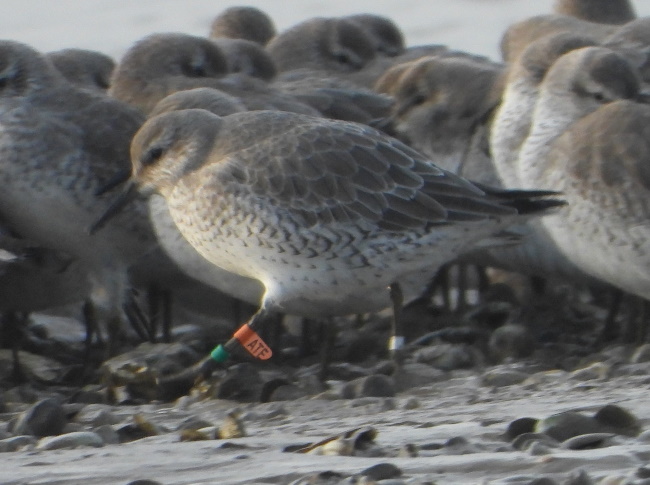Site menu:
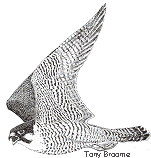
January 2020 Newsletter
Peregrine Falcon.
Colour Ring Report - Knot Special.
December Bird News.
Forthcoming Events.
Latest Newsletter.
Peregrine Falcon
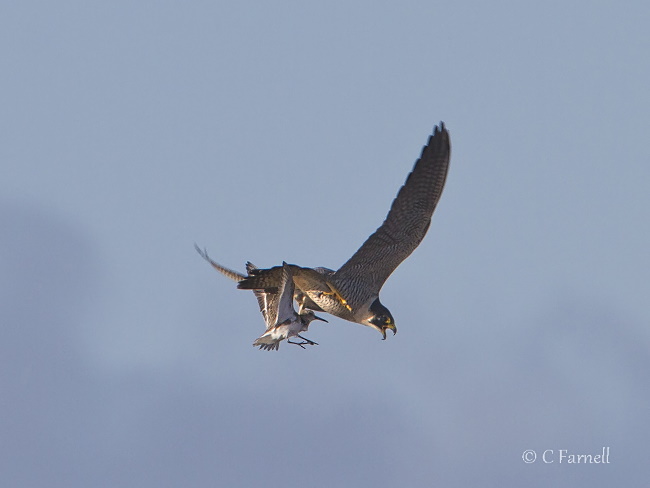
The Peregrine Falcon (Falco
peregrinus) is a ferocious and formidable hunter.
Fast and lethal, Peregrines provide drama every day on the Dee estuary.
We are lucky to have them as there was a real possibility of them going
extinct in the 1950s and 1960s due to the build up of organochlorines
used as pesticides. Looking back at the old Cheshire Bird Reports there
were just two Dee estuary records in 1965, one in 1966 and none at all
in 1967 or 1970. But after the ban of these toxic pesticides there were
already promising signs of a return of this species as early as 1971
with the comment "there are signs generally that this species is making
a come-back after near extinction and increasing records in the county
are evidence of this". Through the 1970s records increased with Burton
Marsh seemingly a favourite area, but it wasn't until 1977 that two
birds were seen together when they flew over Hilbre in October that
year.
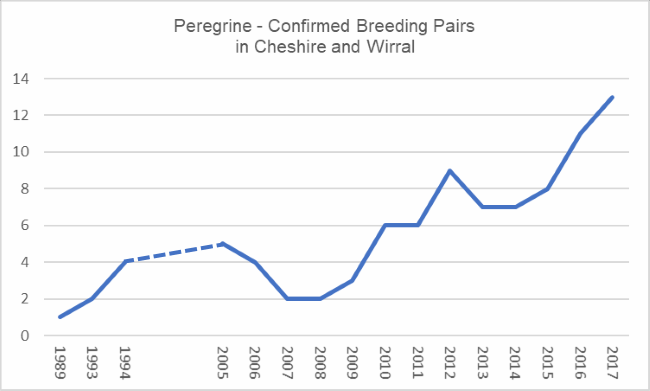
The first ever record of breeding Peregrines in
Cheshire and Wirral was of a pair at Beeston Castle in 1989.
A second pair were recorded in 1993 and the usual level for next 10
years or so was four to five pairs. After a dip in 2007 and 2008 the
number of pairs have steadily increased as can be seen in the
graph. Remarkably, there are no historical breeding records and it
seems
gamekeepers
were at work in the 19th century and the first half of the 20th
century making sure none nested.
There must surely have been Peregrines breeding in suitable habitat in
the distant past but it is quite likely that, with pairs now in double
figures, we have more breeding in Cheshire and Wirral than ever before.
You may wonder how I can say that, but it's simply that, thanks to man
made structures and quarries, there are far more suitable breeding
sites than there ever was in the past.

The same can be said for the whole of the UK, after
the first nationwide survey in 1961 (bizarrely prompted by Pigeon
fanciers complaining about too many Peregrines) numbers have steadily
increased with every succeeding survey which have taken place every 10
to 12 years - see graph below.
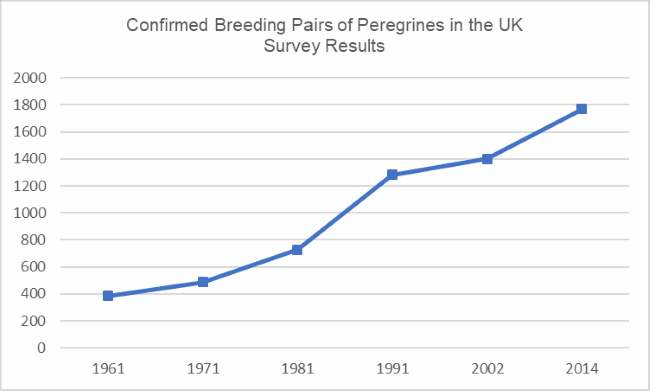
I've concentrated on Cheshire and Wirral Peregrine
records as I have extensive records for the county, but the same
pattern of records apply also to the neighbouring areas of Denbighshire
& Flint (10 confirmed breeding pairs in 2017) and for Lancashire
and north Merseyside (26 confirmed breeding pairs in 2017). The
Peregrine population consists of established pairs which tend to stay
on territory through the year, non-breeding 'spare' adults which are
ready to take over nesting sites if anything happens to the breeding
pairs, young birds and migrants from Scandinavia, although how many of
the latter reach the Dee estuary is unknown. In any case that's a large
number of Peregrines in reach of the Dee estuary, in the CAWOS Atlas
(2008) it was estimated 50 birds were present in Cheshire and Wirral in
the winter, no doubt many of these will visit the estuary at one time
or another.
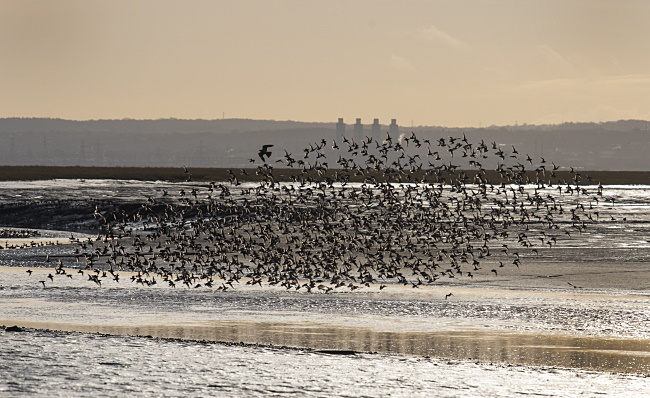
Encounters with Peregrines
Peregrines can be seen anywhere on the estuary,
from distant views of one sitting on a post at Parkgate to dramatic
views of one overhead as it chases a wader flock at Hoylake.
They say only one in ten Peregrine hunts are successful, but that must vary greatly depending on the experience of the Peregrine and the prey species. Since the Knot returned to Thurstaston this summer they have attracted the attention of Peregrines almost on a daily basis. Steve Hinde noticed that initially the Peregrines were making several visits, usually unsuccessful, causing much disturbance to the Knot which often disappeared. But by early autumn it became clear that the Peregrine (perhaps a more experienced bird) was coming in, snatching a Knot first time then flying off and the main Knot flock stayed put. Recently I've noticed that the Knot are reluctant to fly instead just moving around on the ground whilst bunching up tightly and making anxious calls. However if the Peregrine is persistent some knot will take off and I saw one which got separated from the flock desperately trying to escape by flying higher and higher right overhead, but the Peregrine eventually got it and I felt desperately sorry for the wader.
That isn't the only time I've felt sorry for the prey, Leach's Petrels flying past past north Wirral are usually easy prey but one I saw surprised me by twisting and turning trying to escape but it was just too slow battling against the gale to escape. Peregrines will take Leach's Petrel one after another, just eating the nutritious liver before moving on to the next bird. Some birds do escape and I've seen both Knots and Redshanks diving under water again and again before the Peregrine gave up. I've also seen a Pigeon being stooped at, smashing into the marsh then flying off with loose feathers flying everywhere but seemingly uninjured!
Meols at low tide always has a good selection of
waders, mainly Oystercatchers, Redshanks and Knots, and Peregrines
visit regularly hoping for a meal. Recently I was there when the Knots
saw a Peregrine coming and all took flight heading towards Seaforth.
However, the Oystercatchers stayed put on the sand presumably feeling
safer there
than in
the air so I was astonished when the Peregrine just flew down and
picked one off the ground. It was so easy you wonder why they don't
always do that. As at Thurstaston the Knots also sometimes stay put at
Meols and it was interesting seeing several hundred tight up against an
eroded bank of the channel with a Peregrine close overhead unable to
get a clear sight of the Knots which sensibly didn't move.
Peregrines are also regular visitors to Burton Mere
Wetlands giving spectacular views as they cause havoc among the
birds there, and I finish with an extract from the RSPB Burton Mere Wetlands Blog from December 13th
2019: "Peregrines have been having a great time hunting over the
main scrape, stooping and hunting at high speed across the
scrape chasing black-tailed godwits and making teal dive for their
life. We still have yet to figure out which bird of prey is disturbing
the huge flocks of lapwing out on the wet grassland. Either way it has
been spectacular and a magical scene watching them murmurate across the
back of the reserve and as they separate and spread across the sky in
great streams, you lose yourself and remember how special this place
really is."
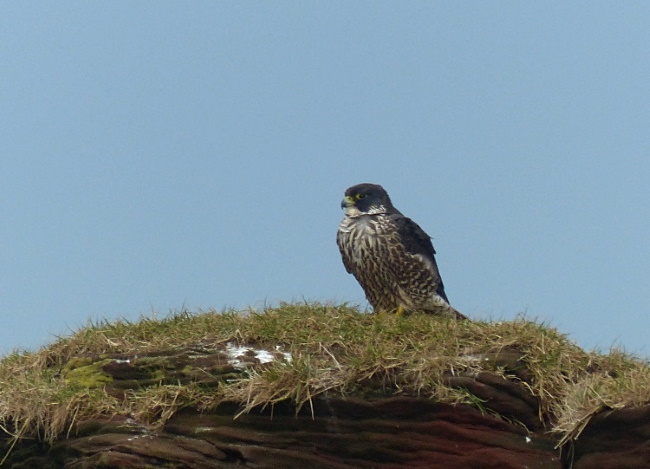
Richard
Smith
References:
1. Rare Breeding Birds Panel Annual Reports http://www.rbbp.org.uk/.
2. Cheshire and Wirral Bird Reports (1964 to 2017) -
CAWOS.
Top of Page
Colour Ring Report - Knot Special
The article below
was written for the December 2019 Waderquest Newsletter and I thought
it would be of interest if I reproduced it here. It does contain bits
from various articles on Knot which have appeared in this Dee Estuary
Newsletter over the years, but also some new material including up to
date data. As you can see we have been busy.
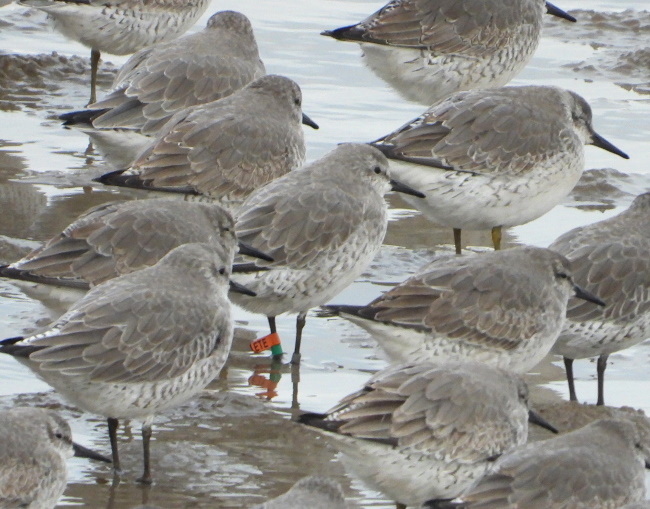
Citizen Science and Red Knots
‘Welcome to the world of wader research’ I thought
as both my boots and tripod sank deep into thick estuarine mud, but
despite the mud I was actually enjoying myself as I was surrounded by
knots. That particular day several thousand were walking towards me as
they fed, coming so close I could almost touch them. Later 20,000 would
all take off from their roost in one noisy roar of wings as a Peregrine
flew by, just fantastic! But what was I doing out there on the Dee
Estuary mud flats? I was reading colour rings/flags as part of the
Altcar Red Knot Colour-Ringing Project.
I’m not some University student doing research for a PhD, or somebody employed by a conservation organisation. I’m just a 70 year old birdwatcher doing a bit of Citizen Science. That’s the beauty of colour rings, reporting just one bird contributes to the research. But here on the Dee Estuary we are not talking about one colour-ringed red knot, we are talking about hundreds and for an obsessive colour ring reader like myself the past two years has been like paradise!
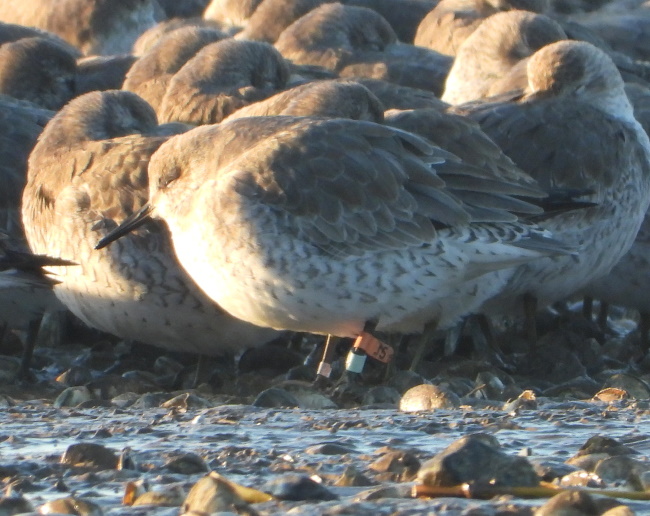
Where
The Dee Estuary is located on the west coast of the United Kingdom, and is part of a mega site which also includes the Mersey, Alt and Ribble Estuaries as well as Morecambe Bay. All this area holds hundreds of thousands of wetland birds and is particularly important during a cold winter when the relatively mild climate means birds can find refuge here from the colder North Sea coasts, including the Waddensea. The red knots are ringed at a wader roost near the village of Altcar which is between Crosby and Formby on the Seaforth coast, just a few kilometres from the Dee estuary to the west and the Ribble estuary to the north.
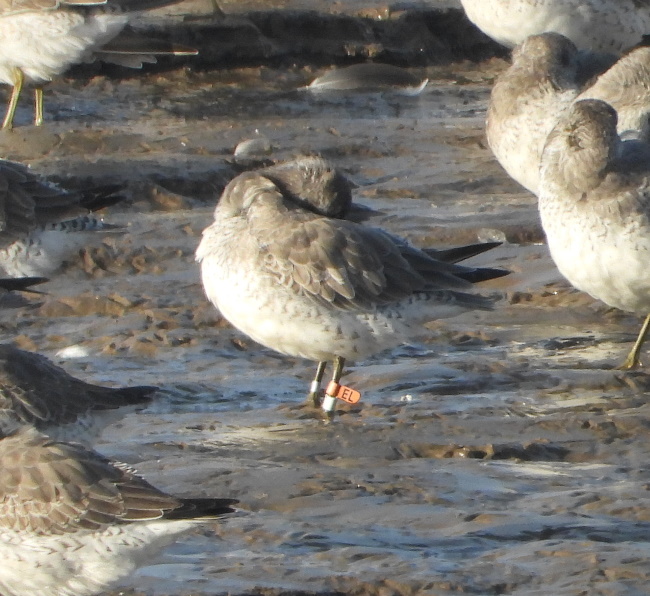
The Altcar Red Knot Colour-Ringing Project
I’ll let Jim Wilson, Red Knot researcher, explain
what this project is all about:
Also there are about 5,000 2y birds summering on the Alt and Ribble. The Alt/Ribble area is one of the most important sites in the North-east Atlantic Flyway for 2y birds (ie the future breeding stock). These have never been studied.
This Research will add focus on the importance of the Alt/Ribble in autumn and spring and also on the huge and uncontrolled disturbance on the Alt/Ribble coast (and elsewhere in the NW UK). Also it will show to what extent the autumn and spring Alt/Ribble populations are using all the NW coast estuaries and other parts of the Irish Sea and if there is a link between the wintering French populations (about 40,000 knots) and the Irish Sea.
Orange Flags
There have been three catches of Red Knot at Altcar
with 519 in September 2017, 494 in March 2018 and 16 in March 2019, a
total of 1029. All have been fitted with an inscribed Orange flag as
shown in the photographs, plus either a pale blue or green ring –
shorthand for which is OfP and OfG. The past two and a bit years since
that first catch has resulted in the most productive work on Red Knot
ever in the UK with a remarkable total of 6293 records of 931 orange
flagged birds, 90% of the total caught which we think is probably a
record.
This is a breakdown by area/country:
|
Area/Country |
Number of
Birds |
Number of
Records |
|
Alt/Ribble
Estuaries |
806 |
3401 |
|
North Wirral/Dee
Estuary |
571 |
2197 |
|
Morecambe Bay |
86 |
166 |
|
Wales |
2 |
2 |
|
Ireland |
62 |
112 |
|
Scotland |
11 |
16 |
|
Iceland |
120 |
206 |
|
Norway |
3 |
6 |
|
Netherlands |
45 |
185 |
|
Germany |
3 |
7 |
|
Azores |
1 |
3 |
|
Mauritania |
1 |
1 |
A lot of people have been involved in recording these birds but by far
the bulk were gathered by just four us with Peter Knight and Rose
Maciewicz with 3177 records (mainly on the Alt/Ribble Estuaries but
also Iceland and Ireland) and Steve Hinde and myself, Richard Smith,
with 2169 records (north Wirral/Dee Estuary). This has meant spending
hundreds of hours on the mud flats, day after day, but we love it even
though our fellow birders think we’re mad!
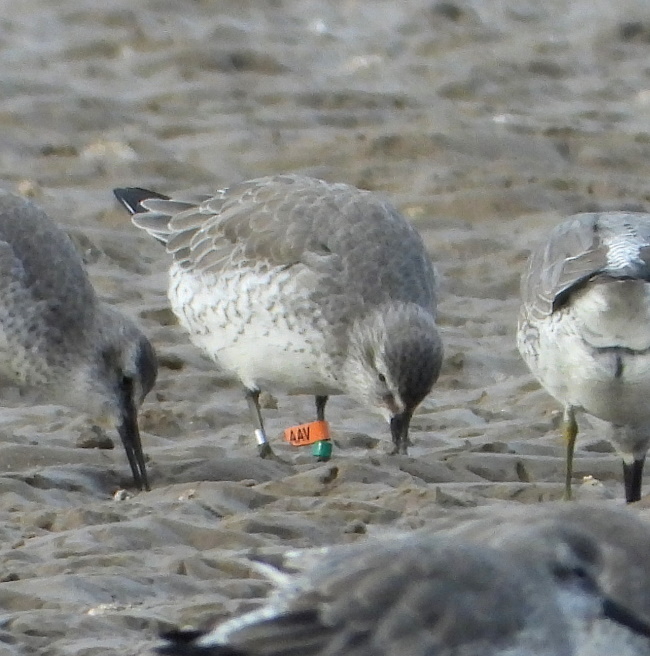
Results
The analysis of all this data, and the data still to
come in over the coming years, is still in the early stages but we’ve
already seen plenty of interest, including:
1. It has been confirmed there is a sub-population of Red Knot which
moult in the Alt/Ribble area post breeding. It is late October before
these birds disperse from there with many flying the short distance to
north Wirral and the Dee Estuary to spend the winter, although many
return to roost in the Alt area (Seaforth/Crosby/Formby) to roost,
particularly on spring tides. Others move north to Morecambe Bay and in
some winters many also fly over to the eastern coast of Ireland where
they have been seen in Dublin and Dundalk Bays. At the end of the
winter they return to the Alt/Ribble area before their spring migration
in May – what we call an ‘Irish Sea winter shuttle’.
2. Many islandica Red Knot stage in Iceland in May before heading to
Canada to breed. Flag reading has shown that the Alt/Ribble birds have
a marked preference to stage in south-west Iceland between the
Reykjanes and Snaefellsnes Peninsulas. Interestingly in late April 2019
a compass bearing was taken of Red Knot leaving Southport beach as they
headed north-west. The bearing of 322° would have taken them straight
to Reykjavik in south-west Iceland.
3. Another staging area used by islandica Red Knot is northern Norway
but very few of the Alt/Ribble birds use this route with only three
birds recorded there.
4. Thanks to colour-ringing we know if it has been a good
breeding season before anybody else! This is because the females leave
the breeding grounds before the males due to the latter’s greater
involvement in brood rearing. The birds were recorded as they arrived
back at Alt/Ribble and by using wing length measured when they
were ringed as a surrogate for sex, the average wing length of each
day’s newly observed Knot was determined to test whether the longer
winged females arrive before the males. In 2018 females did indeed
arrive back before the males and it did turn out to have been a good
breeding season. The 2019 data showed that the first adult Knot
returned about 1 week earlier in the autumn season than in 2018.
Early thoughts were that this might reflect a poor breeding year. This
was short lived when the analysis indicated a very strong females-first
arrival pattern. This was further supported by the observation in late
August of exceptional flocks of 1000+ juvenile Knot on Merseyside, as
well as reports elsewhere in the UK and the Netherlands of large
numbers of juveniles.
5. Some unusual movements have been recorded with one bird turning up
on the Azores in September 2018 and another at Banc d’Arguin,
Mauritania, in December 2018. Islandica
Red Knots are very much vagrants at both locations. The bird recorded
in the Azores made it back to Formby beach where it was recorded in
August 2019.
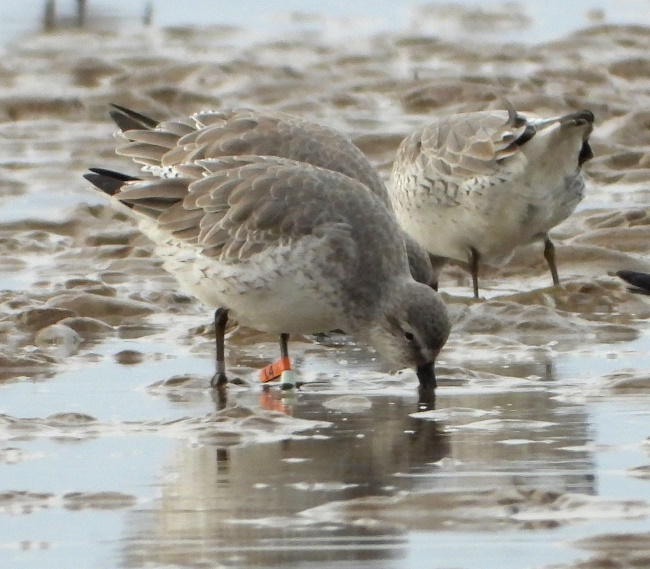
References:
1. Pers. Comms. Jim Wilson 2017 to 2019.
2. Colour Ring Report (October 2017 Dee Estuary Newsletter),
http://www.deeestuary.co.uk/news1017.htm .
3. Richard Smith, ‘Among Knots’, http://www.deeestuary.co.uk/news0218.htm
(February 2018).
4. Peter Knight and Rose Maciewicz, Waders Heading
Off,
http://www.deeestuary.co.uk/news0619.htm (June 2019).
5. Peter Knight and Rose Maciewicz, ‘2 Years on: Some new observations
from the Altcar Red Knot Colour-Ringing Project’, http://www.deeestuary.co.uk/news1119.htm
(November 2019).
Richard Smith
(All Knot photos in this article by Richard Smith © )
December Bird News
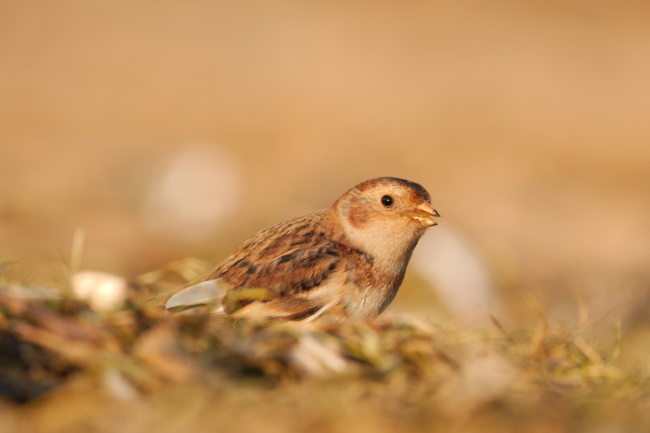
One snow Bunting at the beginning of the month at Point of Ayr was the
only one reported, a Ring Ouzel at Connah's Quay on the 16th was very
much a vagrant for December. A Water Pipit has been regular at Burton
Mere Wetlands.
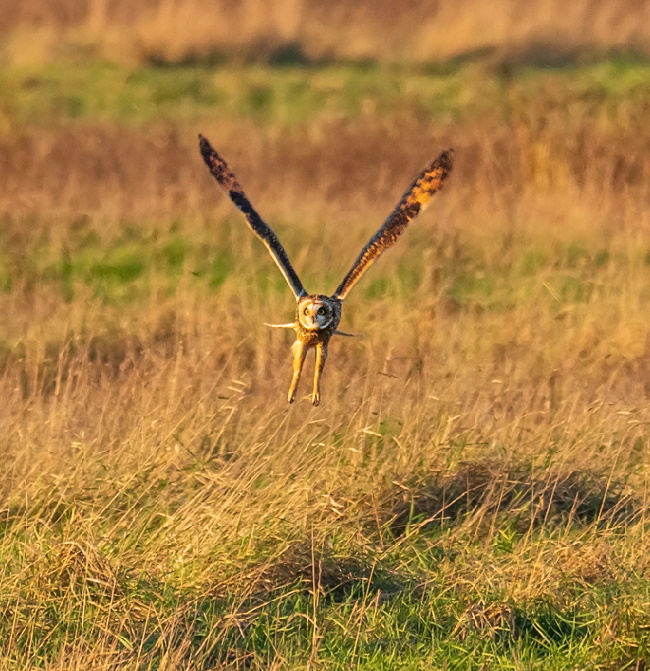
There was plenty of activity on the Marshes with at
least 15 Marsh Harriers, 4 Hen Harriers (including two grey males) and
several Short-eared Owls. Thousands of Pink-footed Geese have been seen
at Burton Mere Wetlands with many feeding on the Dee flood plains
inland of Cheshire whilst several hundred have been flying inland
over Thurstaston most mornings although we haven't discovered where
they are feeding. Brent Geese have been dispersing around the estuary
with small flocks at Hoylake and Thurstaston and over a hundred were
off Heswall out in the middle of the estuary at low tide. Brent Geese
have also been seen on West Kirby Marine Lake alonf with three Shags
and at least 10 Goosanders. A Long-tailed Duck has been on Shotwick
Boating Lake
all month.
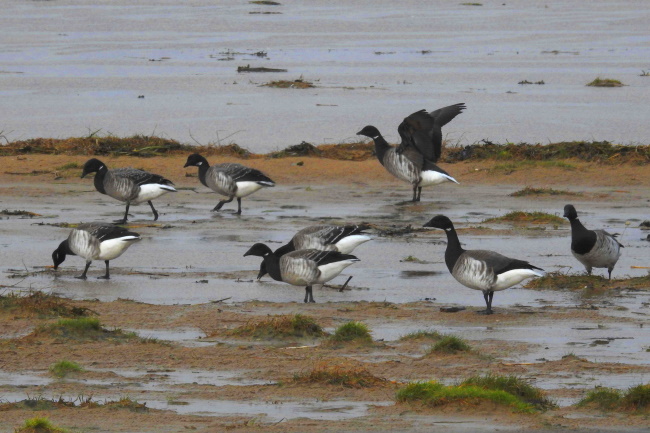
At Thurstaston the low tide Knot roost was building up all month,
reaching 15,000. Knot have also been at Meols and there have been
really close views of them feeding close to the promenade, sometimes
just a few feet away, on the rising tide.
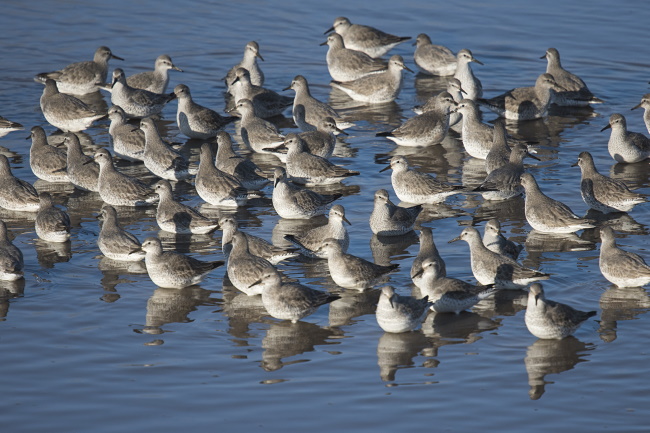
Many thanks go to Mark Gibson, Carole Killikelly, Steve Hinde, Chris Butterworth, David Leeming, Alan Hitchmough, Derek Bates, Allan Conlin, Karen Leeming, Richard Whitby, Tim Kinch, Roy Lowry, Mark Turner, Steve Hart, Matt Thomas, Les Hall, Frank Burns, Jeff Cohen, Elliot Montieth, Sheila Ryde, Dave Edwards, Paul Mason, Charlie Lowe, Dan Carrington, John Hemmings, Mark Peers, Charles Farnell, David Thompson, Hugh Stewart, Eric Burrows, Gavin Butler, Antony Quinn, David Bradshaw, Derek Rowe, David Roe, David Jones, Ian Galt, Dan Trotman, Pete Humphrey, Andy Davis, Paul Ralston, Dave Freeman, Geoff Robinson, Stephen Burke, Richard Payne, David Small, Bill Dickinson, Stephen Wende, Barry Brett, Paul Round, Peter Haslam, Alan Oates, Roger Halsey, Tony Sinnott, Christopher Doran, Andrew Wallbank, Goegg Worthington, the Lighthouse and Wirral Birding Blog, the Dee Estuary Wardens and the Hilbre Bird Observatory for their sightings during December. All sightings are gratefully received.
Top of Page
What to expect in January
If
we get some 'proper' winter weather then we can expect some cold
weather movements with an influx of waders, ducks and geese. Since the
Pink-footed Geese have started using the estuary in their thousands we
haven't really had a very cold winter so if the south Lancashire fields
get covered in thick snow it will be interesting to see just how many
turn up on the marshes here which tend to be largely free of snow.
If we get some cold frosty days with no wind sea-watching is certainly
worth a try with Scoters, Scaup, various divers, Great-crested Grebes,
Red-breasted Mergansers and Goldeneye on view. Some of these birds may
well turn up on West Kirby Marine Lake along with Goosanders and Brent
Geese - giving great views and photo opportunities.
This time of year is always good for both Hen Harriers and Marsh
Harriers, check out the roost at Neston reedbed where Marsh Harriers
should be in double figures. Lookout also for Bearded Tits and Bitterns
there.
Spring tides will bring Purple Sandpipers to the pontoon on New
Brighton Marine Lake, if it's windy we might well get into double
figures.
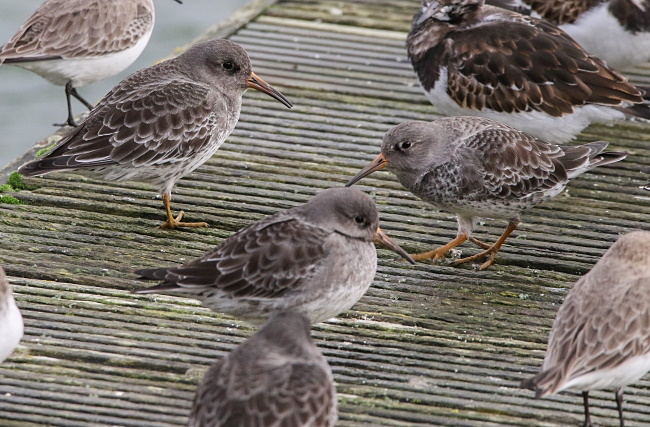
Forthcoming Events
January Highest Spring Tides (Liverpool)
Also see Tides page.
12th January, 12.03hrs (GMT), 9.5m.
13th January, 12.48hrs (GMT), 9.6m.
14th January, 13.34hrs (GMT), 9.5m.
Forthcoming Events
Organised by the Wirral Ranger Service , Flintshire Countryside Service and the RSPB (Dee Estuary): All these events and walks have bird interest, even those not advertised specifically for birdwatching. No need to book for these events unless specified - please check below.
Sunday 5th January,
Big Farmland Bird Walk at Burton Mere
Wetlands.
8-10am
Price: £10 per person / £8 RSPB members (plus Eventbrite booking fees)
Booking essential
Places are limited so advanced booking and payment are essential, via
Eventbrite: https://big-farmland-bird-walk.eventbrite.co.uk
Join us on this exclusive early morning, behind-the-scenes walk to get
closer to the managed farmland parts of the reserve and hopefully find
a range of songbirds alongside large flocks of others you might see on
your Big Garden Birdwatch. Large flocks of small farmland birds -
particularly linnets and reed buntings - feed on our bird cover crop,
along with flocks of gold and greenfinches and other more familiar
garden birds.
Large flocks of small farmland birds - particularly linnets and reed
buntings - feed on our bird cover crop, along with flocks of
goldfinches and chaffinches and other more familiar garden birds. These
in turn can attract merlins, sparrowhawks and hen harriers to hunt. The
sheep pastures on Burton Point are a regular feeding ground for winter
thrushes, green woodpecker and curlew if conditions are wet.
Please note the wildlife spectacle of this event is somewhat
weather-dependent; a cold, hard winter will push more birds to the west
coast, so we'll keep our fingers crossed!
Wellies are recommended with warm, waterproof clothing essential, and
bring binoculars if you have them. Treat yourself to a cup of our
excellent bird-friendly coffee and warm up bedside the wood stove in
the visitor centre afterwards. Places are limited so advanced booking
and payment are essential, via Eventbrite:
https://big-farmland-bird-walk.eventbrite.co.uk
Telephone 0151 353 2720 for further information.
Sunday 12th January
and Sunday 9th February
RSPB Raptorwatch at Parkgate.
1pm-dusk
Join us for a chance to see up to seven different birds of prey
including peregrine and merlin, plus two types of owl that all make
their home on the RSPB Dee Estuary nature reserve. With its panoramic
views of the saltmarsh, Parkgate is one of the best places to watch for
the birds hunting. Stick around until dusk for a chance to see the
graceful and endangered hen harriers flying into roost for the night on
the marsh close to the Old Baths car park, plus a ghostly barn owl
emerging to hunt. No booking required, come along any time between 1pm
and sunset. Dress appropriately for the weather and don't forget your
binoculars! Public toilets and various pubs and cafes are situated
close by along Parkgate promenade.
Telephone 0151 353 2720 for further information.
Saturday 25th
January, Hightide Birdwatch at Hoylake.
10am to noon, High tide at 1115am.
Join the Dee Estuary Voluntary Wardens at Hoylake to see thousands of
waders at high tide, expect to see spectacular numbers of Knot as well
as Dunlin, Grey Plover, Sanderling, Curlew and Oystercatchers. If the
weather is calm we can also get a good selection of divers, grebes and
sea ducks on the sea.
Tuesday 11th
February and Wednesday 12th February, Parkgate
Tidewatch
10.30am-2.30pm
Price: Free
Join us at Parkgate Old Baths for the awe-inspiring spectacle of a high
tide flooding the vast saltmarsh, potentially reaching the old sea wall.
The marsh at Parkgate is one of the best wetland habitats in the
northwest, and when flooded by an incoming tide, the wildlife which
lives here is pushed closer, with chance of seeing the great range of
ducks, geese, wading birds and egrets in big numbers as they are driven
upstream by the rising tide.
A range of birds of prey take advantage of mice and voles flushed from
the grasses; hen and marsh harriers, peregrines and merlins all spend
the winter months on the estuary and this is one of the best places to
watch them, plus short-eared owls if we're really lucky. So why not
venture out to try witness all the drama. Low pressure and a westerly
wind will help push the tide and wildlife in close.
There is free public parking at the Old Baths car park (CH64 6RN) at
the north end of The Parade, and the Wirral Country Park car park on
Station Road (CH64 6QJ). There are public toilets at Mostyn Square in
the middle of The Parade, and a number of pubs and cafes.
Telephone 0151 353 2720 for further information.
Tide times: Tuesday 11 February 10.0m @ 12.35pm, Wednesday 12 February
10.0m @ 1.19pm
